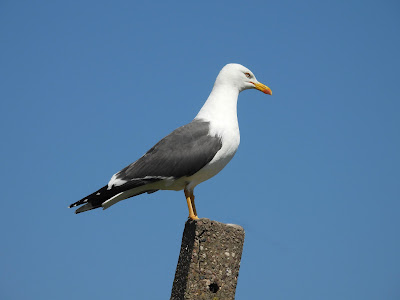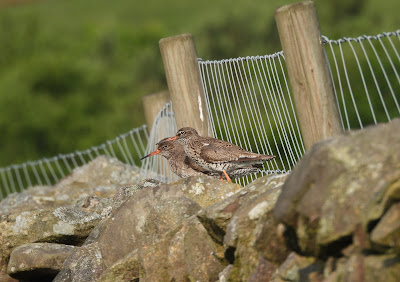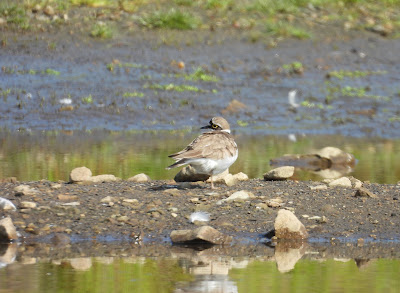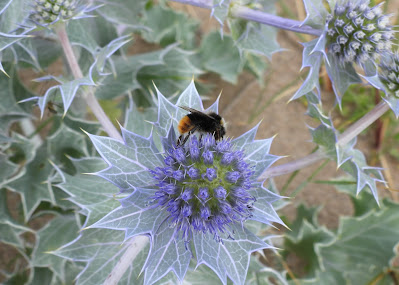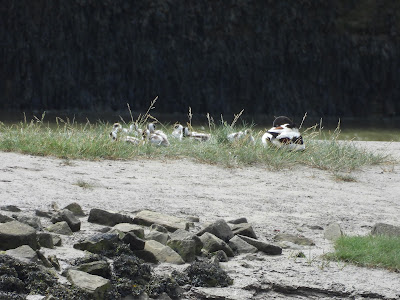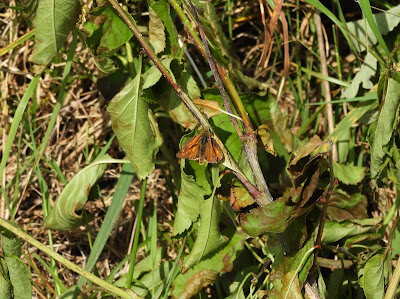I just wanted to start off by saying what a good breeding season it has been for 'our' Pied Flycatchers. At the beginning of June, at our site in the Hodder Valley in Bowland, we ringed the last brood. Eight lively, and healthy chicks, with primary feathers up to two thirds emerged from the sheath. Although we only had five boxes occupied by Pied Flycatchers, all have fledged, and the mean brood size was 7.6, which is excellent, as the average is nearer to seven. It just goes to show what some good weather can do, and also we had a lack of predation, probably as a result of it being a better year for Voles, meaning Stoats and Weasels not turning their attention to the contents of our nest boxes!
We completed the third and final breeding wader survey of the season at my client's farm near Slaidburn in Bowland, on 4th June, and it was very positive in terms of there being lots of chicks about! On my section I recorded four Curlews, with a further two alarm calling, so they obviously have chicks. Most of the Curlews are not in my patch, and are in Hilary's, where she is monitoring at least five pairs with chicks.
A pair of Redshanks were keeping an eye on me from on top of a wall, and close to a scrape on the other side of the wall, I could see a Redshank chick feeding along the edge of the scrape. Another pair of Redshanks obviously had chicks, because every time I got out of my car, they were flying round, alarm calling. When I got back in they would land, start 'chipping', calling to their chicks, but the habitat is so good that I couldn't see them.
Redshanks (above & below)
I found two pairs of Oystercatchers, each with three pretty large chicks, and two females still sitting on eggs. I recorded three Snipes on my patch, including a couple of chipping birds, so I knew that they had chicks as well.
Close to where the second pair of Redshanks were, I found a pair of Lapwings with four large chicks, that were very close to flying. I picked one of the chicks up, and it was a chick that I had ringed at the end of April, so it was pleasing to know that this brood had made it! A total opposite to this brood, was a pair of Lapwings with a brood of four small chicks that I found later in the morning. I managed to pick up three out of the four and ring them.
The large lapwing chick that I picked up, that I had ringed as a very small chick at the end of April.
One of the three small Lapwing chicks that I ringed.
The Little Ringed Plovers had just one chick, bit it was quite large, so fingers cross that it fledges okay. I also had a pair of alarm calling Common Sandpipers, but I wasn't able to locate the chicks.It was still very positive though, just knowing that they had chicks.
Throughout the survey, I also had a Cuckoo calling, two Willow Warblers, and two Sedge Warblers singing, three Swifts, and about a dozen Brown Hares.
A couple of days later, Gail and I had a walk along the Wyre estuary from the quay, and out on the mud where the dock channel joins the river, 1,255 Herring Gulls were roosting. They were all sub-adult birds, and surprisingly there were only two Lesser Black-backed Gulls amongst them.
Insect activity was restricted to 27 Buff-tailed Bumblebees, two Common Carder Bees, five Red-tailed Bumblebees, a Large White, a Small White, and two Common Drone Flies. Flowering plants included Hoary Mustard, Dog Rose, Field Bind-weed, Common Toadflax, Kidney Vetch, Oxeye Daisy, Common Carrot, and Yarrow.
Towards mid-month, we visited our good friends, Robert and Diana's farm, near Nateby to check the Kestrels. There were five young. Three were big enough to ring, and two were too small. We ringed the three chicks that were big enough, and agreed to check them again in a week to see how the two small ones were getting on. If the adults are struggling to find enough food, the smaller chicks can end up as food for their older siblings. However, the signs were good, as the box was littered with the corpses of small mammals, and the odd bird, a good sign of plentiful food.
We were back in a week, and it coincided with a visit from a local primary school. We went up to the box, and the two small chicks had caught their siblings up, and were looking fit and healthy. We ringed the two chicks, and the pupils from the primary school got the opportunity to see two Kestrel chicks up close, and personal, and they were delighted. Hopefully, it will create a lasting memory for them, and inspire them to remain connected to nature.
One of the Kestrel chicks originally too small to ring, a week later. A week after the last breeding wader survey in Bowland, Gail and I returned to the farm to see if we could perhaps ring a few of the waders chicks, but they were all too large, and virtually flying. The important thing, is that they had made it to the fledging stage, so that was good enough for us.
On one of the scrapes there was a flock of 18 Lapwings, and half of them were recently fledged young, so that was good to see. We still had a female on eggs on the large scrape, so they are going to be a late brood. In fact, close to this female was an Oystercatcher sitting, so another late brood. We had two broods of Oystercatchers with big young, and the pair of Common Sandpipers that were alarm calling last week, had three chicks that were capable of flight!
A couple of days later I had a solo outing in the dunes at Fleetwood to see what was flowering. It was mid-morning, and it was quite warm and sunny, and a few bits and pieces were flowering. I recorded flowering Sea Holly (not quite with full blue blush), Bird's-foot Trefoil, Smooth Hawk's-beard, Common Restharrow, Sea Spurge, Sea Sandwort, Sea Rocket, and Broad-leaved Everlasting-pea.
A few Buff-tailed and Red-tailed Bumblebees were on the wing, and I had the common hover fly, Migrant Aphideater Eupeodes corollae.
Since my last post, we have had our garden light trap out on several occasions, and like last time I'll just lump my totals together. We recorded two Green Pugs, 25 Heart and Darts, four Bee Moths, six Australian Orange-tips, six Marbled Orchard Tortrix, a White Ermine, a Barred Fruit-tree Tortrix, 15 Dark Arches, 12 Riband Waves, three Common Plumes, nine Garden Grass-veneers, four Mottled Rustics, a Middle-barred Minor, a Wormwood Pug, two Minor sp., a Puss Moth, two Small Clouded Brindles, three Lesser Yellow Underwings, nine Large Yellow Underwings, a Silver Y, two Brimstone Moths, a Eudonia mercurella, a possible Marbled Minor, a Swallow-tailed Moth, two Scalloped Oaks, a Eudonia lacustrata, two Cabbage Moths, a Small Orchard Tortrix, an Elephant Hawkmoth, three Bright-line Brown-eyes, two Codling Moths, a Common Pug, a Miller, an Eyed Hawkmoth, a Udea prunalis, two Garden Carpets, four Single-dotted Waves, a Clay, a Willow Beauty, a Anania coronata, a Mottled Beauty, a Fan-foot, a Large Pale Masoner, a Twenty-plume Moth, five Buff Ermines, two Common Rustics, a Clouded Border, and an Uncertain.
Puss Moth (above & below)
Elephant Hawkmoth (above & below)
I had another walk through the dunes on 13th June, and in addition to my last visit, I had flowering Dog-rose, Field Bindweed, Sea Holly, Sea Raddish, Bloody Crane's-bill, and Common Evening-primrose. I came across some fungi that after consultation with fungal guru Dave, it looked good for Dune Brittle Stem, but it would require microscopy to clinch it. It was quite windy, so insect activity was low, but there were large numbers of Buff-tailed Bumblebees foraging on the Restharrow.
Possible Dune Brittlestem
I then had a walk along the quay, and plants were the order of the day again. In addition to my last visit I had flowering Sea Raddish, Red Clover, Bird's-foot Trefoil, Hedge Mustard, Red Valerian, Yarrow, Ragwort, Lesser Trefoil, Common Evening-primrose, and White Clover.
There was a pair of Shelducks in the quay with eight young, and I also had a pair of Herring Gulls with a chick on the old ferry structure. A few insects were on the wing including Small White, Small Tortoiseshell, Large Skipper, and Red Admiral butterflies.
Smack, bang in the middle of the month, Gail and I completed our Wetland Bird Survey (WeBS). Wetland birds were a little thin on the ground, with a Cormorant, three Lesser Black-backed Gulls, twelve Shelducks (eight ducklings), and 19 Herring Gulls in the docks, and eight Mute Swans (6 cygnets), four Little Grebes, two Coots, and two Moorhens on the reservoir alongside the estuary.
On our walk down to the reservoir we had a Lesser Whitethroat, a juvenile Kestrel, two Blackcaps, a Reed Bunting, a Cetti's Warbler, three Chiffchaffs, two Song Thrushes, four Whitethroats, a Sedge Warbler, two Stock Doves, and two Reed Warblers.
On the 19th June, Gail and I had our first ringing session for a while at the Nature Park, and the net rides needed a little bit of a trim. We ringed nine birds as follows:
Robin - 3 (juveniles)
Reed Warbler - 1 (adult male)
Blackcap - 1 (juvenile)
Great Tit - 2 (juveniles)
Willow Warbler - 1 (juvenile)
Dunnock - 1 (juvenile)
A few warbler species were singing during the morning, and we had two Chiffchaffs, two Cetti's Warblers, two Sedge Warblers, two Whitethroats, and a Reed Warbler. Close to where we park our car, and set up our base, a Woodpigeon was continually collecting small sticks, and carrying them to a nest within a dense Willow sp. I'm guessing this is in preparation for brood number two of the summer.
After we had packed up, we had a look on the pools and recorded a pair of Tufted Ducks, 36 Coots (six young), four Little Grebes, 41 Mallards, four Moorhens, and a Canada Goose. Six Swifts and four House Martins were 'hawking' for insects over the pools, and a female Emperor Dragonfly was oviposting on one of the pools.
We've had a few new moth species for our garden this year, as we do most years, but I missed out on a spectacular one, in the form of a Hummingbird Hawkmoth that Gail spotted visiting Lavender next to our back door!
Also, new species don't always come via our garden light trap. On 1st July I could see an unusual moth on the outside of the glass in the front door. I opened the door, and there was our first Twenty-plume moth. Unfortunately, it flew off before I could get a shot. Then a couple of days later during the afternoon, sat in our sun lounge drinking coffee, I noticed the shadow of a lepidopteran form fluttering between the blinds and the window, and it was a gorgeous Clouded Border. Fortunately, I was able to capture it and release it in the garden, and also get a few 'snaps' of it!
Towards the end of June, we had another walk through the dunes, and again lots of plants were flowering. The Sea Holly was looking spectacular, and there was lots of it distributed across the dunes; a vivid blue sea of Sea Holly! I don't think we added much plant-wise to recent visits other than perhaps Common Mallow, Lesser Trefoil, Biting Stonecrop, and Common Carrot.
Sea Holly (above & below)
Lots of 'Whites' were on the wing, with at least 16 Small, and 11 Large. As usual there were quite a few House Sparrows in the dunes, and we had somewhere in the region of 15 - 20.
I am going to declare 26th June as the first day of autumn in 2025, as that was the date that we had our first returning waders. We had a flock of 20 Curlews heading upstream along the River Wyre, near Jubilee Quay, and we also had our first returning Black-headed Gull. So it's official, it's Autumn!
On the same visit we noted that the Shelducks still had all eight young, so that's good, and the Herring Gull chick was still on the old ferry terminal.
We recorded a Shaded Broad-bar, and other invertebrates included ten Small White butterflies, two Large Whites, a Small Tortoiseshell, and a Field Grasshopper. A female Sparrowhawk was also of interest.
Another sign of autumn, just three days later at the same location, was a group of three Chiffchaffs. They don't breed on site, but they won't have come that far, but it is still a bit of early autumnal migration!
On 2nd July we were back at the quay, and we noted that Little Egret numbers had built up to five. As the weeks, and months move on, this number will increase further. Another early autumn observation. Our best record during our visit was a Hummingbird Hawkmoth that we had foraging on Red Valerian. I managed to get a few record shots, which you can see below.
In early July we had a new species of hoverfly for the garden, and indeed it was new for us, it was a gorgeous Scaeva pyrastri. One of its common names is Pied Hoverfly, and if you look at the image below you can see why.
To bring you right up to date, we had some more autumnal sightings at the quay this morning, with our first returning Redshanks, a group of six. Black-headed Gull numbers had also increased to four. the Shelducks were all accounted for, as was the Herring Gull chick. It was warm, but windy, with 20 - 25 mph south-westerly wind, so there was little insect activity, just two Common Blue butterflies, eight Small Whites, a Red-tailed Bumblebee, and two Buff-tailed Bumblebees.
Hopefully we'll have some settled whether over the next few weeks, as July can be our best month for monitoring early autumn warbler movement through the reedbed. Fingers crossed.







